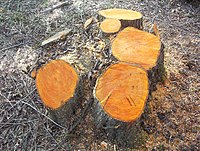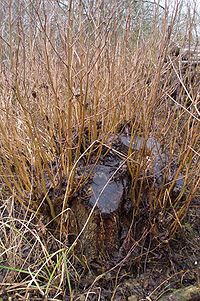
Back Percullo AN تنسيغ Arabic Atoñu AST কপিচিং Bengali/Bangla Bosc menut Catalan Výmladkový les Czech Stævningsskov Danish Niederwald German Kopsado Esperanto Vástago Spanish
Coppicing /ˈkɒpɪsɪŋ/ is the traditional method in woodland management of cutting down a tree to a stump, which in many species encourages new shoots to grow from the stump or roots, thus ultimately regrowing the tree. A forest or grove that has been subject to coppicing is called a copse /kɒps/ or coppice, in which young tree stems are repeatedly cut down to near ground level. The resulting living stumps are called stools. New growth emerges, and after a number of years, the coppiced trees are harvested, and the cycle begins anew. Pollarding is a similar process carried out at a higher level on the tree in order to prevent grazing animals from eating new shoots.[1] Daisugi (台杉, where sugi refers to Japanese cedar), is a similar Japanese technique.[2][3]
Many silviculture practices involve cutting and regrowth; coppicing has been of significance in many parts of lowland temperate Europe.[citation needed] The widespread and long-term practice of coppicing as a landscape-scale industry is something that remains of special importance in southern England.[4] Many of the English language terms referenced in this article are particularly relevant to historic and contemporary practice in that area.
Typically a coppiced woodland is harvested in sections or coups[5] on a rotation. In this way, a crop is available each year somewhere in the woodland. Coppicing has the effect of providing a rich variety of habitats, as the woodland always has a range of different-aged coppice growing in it, which is beneficial for biodiversity. The cycle length depends upon the species cut, the local custom, and the use of the product. Birch can be coppiced for faggots on a three- or four-year cycle, whereas oak can be coppiced over a fifty-year cycle for poles or firewood.
Trees being coppiced do not die of old age as coppicing maintains the tree at a juvenile stage, allowing them to reach immense ages.[1] The age of a stool may be estimated from its diameter; some are so large—as much as 5.5 metres (18 ft) across—that they are thought to have been continually coppiced for centuries.[6]
- ^ a b De Decker, Kris (n.d.). "How to Make Biomass Energy Sustainable Again". Low-Tech Magazine. Retrieved 27 April 2021.
- ^ "Incredible 15th-Century Japanese Technique for Growing Ultra-Straight Cedar Trees". My Modern Met. 31 July 2020. Retrieved 19 August 2020.
- ^ Taaffe, Gerard (26 September 2002). "Trees that tower over the past and present". The Japan Times. Retrieved 19 August 2020.
...known as dai-sugi. This is a coppiced sugi ...
- ^ Bartlett, Debbie (4 April 2016). "Traditional coppice in South East England: the importance of workforce engagement for development". IForest - Biogeosciences and Forestry. 9 (4): 577–582. doi:10.3832/ifor1809-009. Retrieved 1 January 2024.
- ^ Coup (French coup, 'cut') is pronounced /ˈkuːp/ in this context.
- ^ Rackham, Oliver (1980). "The medieval landscape of Essex" (PDF). In D. G. Buckley (ed.). Archaeology in Essex to AD 1500 (Report). CBA Research Reports. The Council for British Archaeology. p. 104. Retrieved 25 July 2022.
© MMXXIII Rich X Search. We shall prevail. All rights reserved. Rich X Search

